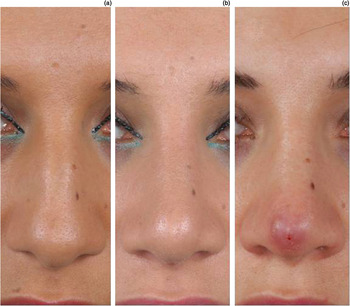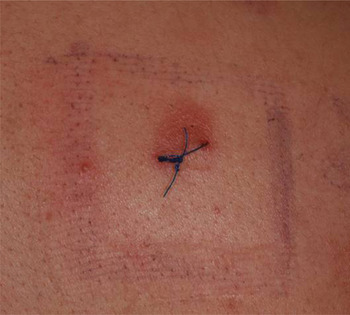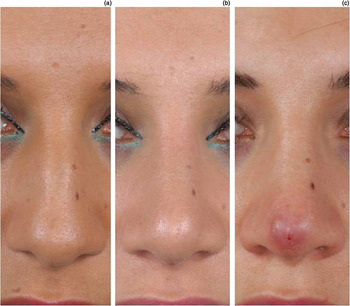Introduction
Rhinoplasty is a surgical procedure which is usually indicated to improve the nasal breathing function and cosmetic appearance of the nose. Both aesthetic and non-aesthetic complications of rhinoplasty have been reported.Reference Holt, Garner and McLarey 1 – Reference Eloy, Jacobson, Elahi and Shohet 3
Post-rhinoplasty infection of the nose is a much less frequently encountered complication, and is not well documented. Foda investigated 500 external rhinoplasty cases, and described a post-operative infection rate of 2.4 per cent.Reference Foda 4 When infection of the nasal tip occurs, it is expected to manifest within the first few weeks of nasal surgery. If not promptly recognised and appropriately treated, more morbid sequelae may result, such as abscess or necrosis of the nasal tip, bacterial meningitis, and cavernous sinus thrombosis.Reference Holt, Garner and McLarey 1 Nasal tip abscess and necrosis may cause aesthetic problems, impede normal social contact, and create self-identity problems for affected patients.
This paper aims to describe what we believe to be the first reported case of nasal tip abscess with an adverse skin reaction to Prolene following rhinoplasty. To the best of our knowledge, and following a literature search, we are not aware of any previous reports of this unusual presentation of nasal tip abscess.
Case report
The patient was a 26-year-old woman who had undergone functional septo-rhinoplasty 2 years prior to presentation, in order to correct a nasal breathing obstruction caused by a shifted external nasal pyramid. Eight weeks after this septo-rhinoplasty, the patient had felt satisfied and comfortable (Figures 1a and 1b).

Fig. 1 The patient (a) before, (b) eight weeks after and (c) two years after septorhinoplasty, the latter showing the nasal tip abscess.
Six months after septo-rhinoplasty, the patient had complained for a short period of time about a subjective swelling sensation and a recurrent feeling of pressure at the nasal tip, but clinical examination showed no pathological findings.
Two years after her septo-rhinoplasty, the patient presented again with a painful, grossly disfigured nasal tip, which was swollen with redness of the overlying skin (Figure 1c). The nasal cavities were normal and showed no discharge. There were no similar swellings in other parts of the body, and no history of tobacco sniffing, nasal topical medication, diabetes mellitus or immunosuppression. Symptoms of rhinological, otological, ophthalmic, neurological, dental, neck and allergic disease were excluded. There was no history of nasal manipulation.
Examination of the ears, eyes, oral cavity, oropharynx and neck revealed normal findings.
An aspiration biopsy of the nasal tip swelling was performed, drawing approximately 1 ml of pus. A clinical diagnosis of nasal tip abscess was made. The microscopy, culture and sensitivity report described a few haemolytic streptococci group C bacteria.
The patient underwent initial treatment with endonasal drainage of the nasal tip abscess, and post-operative treatment including antiseptic dressings and intravenous antibiosis with cefuroxime.
After initial clinical improvement, the patient showed a recurrent and residual, painful nasal tip swelling and redness.
Thus, she was scheduled for revision rhinoplasty, which was performed three months after the initial abscess drainage. The intra-operative findings included thin nasal tip skin tethering to the underlying subcutaneous tissue, and granulation tissue with interspersed pockets of pus and knotted Prolene. The knotted Prolene was removed and the bed irrigated copiously with hydrogen peroxide. Histological studies of a subcutaneous tissue biopsy showed unspecific abscess formation.
Post-operatively, the patient showed sustained clinical improvement, with complete resolution of the nasal tip swelling and redness. During an observation period of more than one year, she had no further complaints.
In order to test for any adverse skin reaction against the thread material, Prolene was applied to the patient's back, firstly as a patch test (i.e. pieces of thread in petroleum jelly under occlusion for 2 days) and secondly as a cutaneous suture. Tests were assessed after 48 and 72 hours. There was no reaction to the patch test, but an erythematous infiltrate with papules and vesicles was observed around the sutured thread at both time points (Figure 2). A skin biopsy was taken from beside the Prolene suture; histopathological analysis revealed disturbed epidermal differentiation with a dermal lichenoid inflammation beneath a lichenoid interface dermatitis. The baseline series of the German Contact Dermatitis Research Group, including sodium lauryl sulphate (0.25 per cent in water), patch-tested in parallel, did not show any positive reaction. Although we wished to perform further investigations in order to patch-test the single constituent parts of Prolene sutures, the patient did not consent to any further testing.

Fig. 2 The test Prolene suture in the patient's back, 72 hours after placement.
Discussion
The nasal tip is an essential part of the nose which contributes significantly to the facial appearance and hence to each individual's beauty. If it is affected by infectious, neoplastic or traumatic lesions, gross distortion may result, with unacceptable aesthetic results. The function of the nose may also be compromised.
Post-rhinoplasty infection is much less frequently encountered than one would expect, given that surgery is performed in a non-sterile field. Nasal tip abscess as a complication of rhinoplasty is uncommon, and is defined as the accumulation of pus in the subcutaneous space under the nasal tip skin. The actual incidence of nasal tip abscess following rhinoplasty is unknown because little attention is paid to this complication. When it occurs, it usually presents within a few weeks of nasal surgery.Reference Holt, Garner and McLarey 1 Late manifestation of nasal tip abscess two years after rhinoplasty has not previous been reported.
Such late presentation should prompt consideration of a more sinister differential diagnosis, including granulomatous conditions,Reference Luis-Montoya, Saez-de Ocariz Mdel and Vega-Memije 5 ulcerative colitis,Reference Yilmaz, Yüksel, Coban, Cakmak, Basar and Ekiz 6 immunocompromiseReference Sandel and Davison 7 – Reference Shah, Murr and Lee 9 and nasal cancer, rather than just a non-specific infective abscess. In the presented patient, however, microbiological and histological analysis did not support the occurrence of granulomatous disease or cancer.
Microbiological culture of our patient's nasal tip abscess and granulation tissue grew a few haemolytic group C streptococci organisms. This bacteria is one of the pathogenic organisms which have been implicated in upper airway tract infections, including sinusitis and septal abscess.Reference Anon 10 , Reference Olwoch 11
The usual clinical presentation of nasal tip abscess is as described in our patient. Trauma to the nose should be considered as a significant risk factor. Repeated incidents can result in continuous, unnoticed micro-trauma to the healing nasal scar; inoculation of pathogenic organisms may occur, resulting in infection and abscess formation.
Prolene (Ethicon, Somerville, New Jersey, USA) is a synthetic, sterile, inert, non-absorbable, monofilament, surgical suture composed of an isotactic crystalline stereoisomer of polypropylene, a synthetic linear polyofelin. The thread may be colourless or coloured with phthalocyanine blue, as in our case. Prolene sutures are usually used for general soft tissue approximation or ligation.
Cases of adverse cutaneous reactions to Prolene are rarely reported, whereas other suture materials (e.g. nylon,Reference Elosua de Juan, Lopez Garcia, Bove Guri, Mata Diaz and Martinez Garchitorena 12 – Reference Stewart and Kimbrough 15 silkReference Marcus, Roy, Sullivan and Sutton 16 – Reference Kurosaki, Otsuka, Kunitomo, Koyama, Pawankar and Matomuto 18 and catgut)Reference Engler, Weber and Turnicky 19 are more frequently described as eliciting allergic reactions.
The earliest report of an adverse cutaneous reaction to Prolene, published in 1986, described the development of giant papillary conjunctivitis from an exposed Prolene suture; unfortunately, no patch-test was performed.Reference Skrypuch and Willis 20 In the following years, several other cases were published.
In 2003, a case was reported of a 68-year-old woman who was admitted to hospital for corneal transplantation.Reference Sanchez-Morillas, Reano Martos, Rodriguez Mosquera, Iglesias Cadarso, Perez Pimiento and Dominguez Lazaro 21 She was referred to investigate the possibility of an allergic reaction to Prolene suture material, and a patch test was positive for Prolene, showing perivascular inflammation with abundant lymphocytes in the skin biopsy. Twenty years earlier, an abdominal surgical procedure had been performed. Seven days after this surgery, the patient had reported pain in the suture area and had suffered a spontaneous rupture of the surgical scar.
In 2006, two other cases of skin reactions to suture materials were reported. One patient suffered from refractory eczematous dermatitis related to a residual Prolene suture, following excision of dermatofibrosarcoma protuberans; removal of the retained suture material improved the patient's symptoms dramatically.Reference Ascherman, Hunter and Bickers 22 The second patient suffered conjunctival inflammation secondary to a retained polypropylene suture, and had a history of ptosis surgery.Reference Chung, Feder, Weston and Bryar 23
In addition to the suture material itself, the colouring agents used in sutures can, rarely, be responsible for allergic reactions.Reference Hausen 24 , Reference Raap, Wieczorek, Kapp and Wedi 25 Our patient did not consent to any further investigation, and it was therefore not possible to undertake patch-testing of the colouring agent used in blue Prolene thread, nor to perform patch-testing of different suture materials.
-
• Nasal tip abscess is a rare long term complication of rhinoplasty
-
• Non-absorbable subcutaneous suture use (e.g. Prolene) is a potential risk factor for adverse skin reactions
Gabrielli et al. Reference Gabrielli, Potenza, Puddu, Sera, Masini and Abeni 26 systematically investigated the role of different suture materials in infection, tissue reactivity and wound dehiscence in plastic surgery out-patients. The use of silk and polyglactin 910 was associated with a moderate increase in the risk of tissue reactivity, while thinner internal sutures had a protective effect. Male sex, older age, wound side, and the length of operations performed by less experienced surgeons were all associated with a higher risk of wound complication.
In addition to these, much more pronounced risk factors, an adverse skin reaction to Prolene or other suture materials should be kept in mind, especially in patients with a long term complication.




